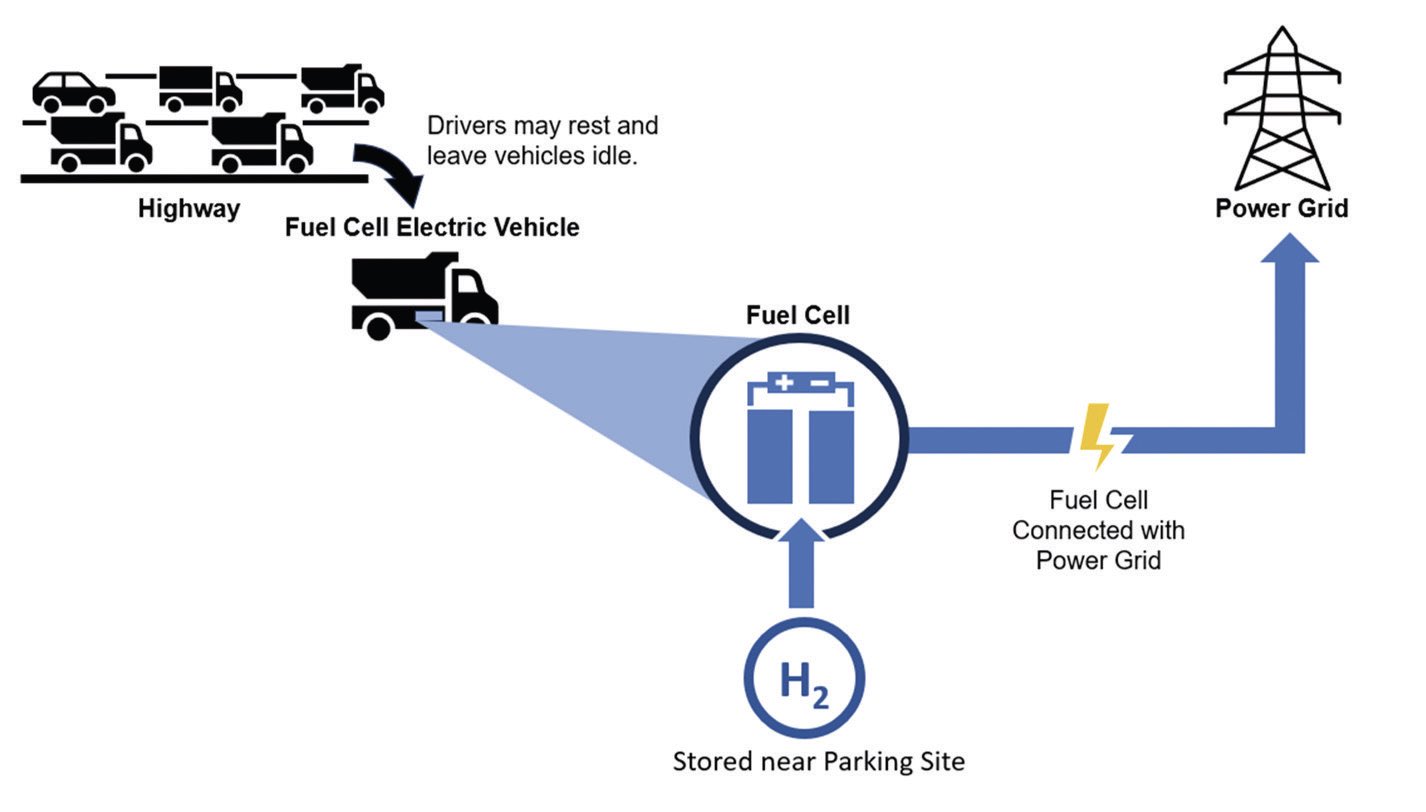HIGHLIGHTS
•
Heavy-duty trucks powered by fuel cells can be used as portable energy generators to support the electric grid.
•
A theoretical study found that truck-to-grid hydrogen fuel stations are able to support the electric grind in the Canadian province of Alberta if sufficient trucks are available.
•
At least four fuel cell powered trucks are needed for the vehicle-to-grid fueling station to be profitable and to generate electricity cleaner than grid electricity.
The transition to electrification is increasing the demand for power, which is stressing electric grids that are not designed to handle this scenario. This trend has led to the growing use of energy storage as a means to support electric grids during times of high demand.
A previous TLT article
1 discusses the implementation of an energy storage technique known as pumped storage hydropower. Water is pumped from a lower reservoir to an upper reservoir during periods when electricity supply is greater than demand. For periods of high demand, the water in the upper reservoir is released to the lower reservoir under the influence of gravity. The potential energy of the water is converted into kinetic energy by driving turbines to generate electricity. The cost of this approach can be reduced through the prefabrication of structural steel modules used in their construction and in using a closed-loop pump storage system to conserve water.
Xiao-Yu Wu, professor in the department of mechanical and mechatronics engineering at the University of Waterloo in Waterloo, Ontario, Canada, says, “Pumped storage hydroelectricity, batteries and hydrogen are examples of energy storage technologies that are feasible but require a large investment in site preparation and device purchases. Figuring out a strategy for storing renewable energy that can be utilized for a long period of time such as the winter season is challenging.”
Wu proposes a different strategy to provide power to the electric grid during times of high demand
(see Figure 2). He says, “Portable electricity generators are an appealing option if they can generate sufficiently high levels of power to make a difference. The most viable way to achieve this goal is to use heavy-duty trucks that are powered by fuel cells. During periods of inactivity, trucks will be able to park at vehicle-to-grid fueling stations that contain hydrogen produced from renewable energy sources. In effect, hydrogen storage in the station is similar to a gasoline reservoir. The fuel cells in the trucks will then tap into the hydrogen present to generate electricity that can then be sent to the grid.”
 Figure 2. A schematic shows how fuel cell powered electric vehicles can generate electricity to support a power grid. Figure courtesy of Daniel Ding, University of Waterloo.
Figure 2. A schematic shows how fuel cell powered electric vehicles can generate electricity to support a power grid. Figure courtesy of Daniel Ding, University of Waterloo.
Batteries are a less viable option because of their low energy density and longer charging times. In contrast, hydrogen will have a shorter refueling time for trucks, a higher mass-specific energy and power.
Transportation is currently a large source of greenhouse gas emissions. Utilizing fuel cell powered trucks to provide renewable energy to the grid may not only reduce emissions from transportation but also from power generation. Wu says, “In Canada, there is heavy truck traffic on the main highways in the province of Alberta. This area of Western Canada also is highly reliant on fossil fuels for producing electricity. The cost of energy in Alberta also is higher than in other Canadian provinces. These factors led us to conduct a theoretical study to determine if fuel cell powered trucks parked at vehicle-to-grid hydrogen fuel stations can contribute power to the grid in a cost effective manner.
Mixed integer linear programming
Wu and his colleague Daniel Ding, graduate student at the University of Waterloo, produced a theoretical model using mixed integer linear programming that exhibits potential for using vehicle-to-grid hydrogen fuel stations to support the Alberta electric grid if a sufficient number of trucks are acting as electricity generators. In developing the model, the researchers assumed that hydrogen can be sourced either locally from the fuel station (known as grid hydrogen) or from hydrogen pipelines (market hydrogen). The hydrogen manufactured and stored at the fuel station is produced using an onsite electrolyzer powered by excess electricity at night. Market hydrogen originates from a centralized production site that utilizes renewable energy.
 Utilizing fuel cell powered trucks to provide renewable energy to the grid may not only reduce emissions from transportation but also from power generation.
Utilizing fuel cell powered trucks to provide renewable energy to the grid may not only reduce emissions from transportation but also from power generation.
Wu says, “Our objective was to maximize the operating profit realized in using fuel cell powered trucks to support the grid. This figure is equivalent to the product of the electricity price and the fuel cell power output minus the cost of the hydrogen feedstock and the cost of the actual fueling process.”
The vehicle-to-grid model operates under several constraints. Wu says, “We are assuming that enough trucks are running to allow for some to be able to act as electricity generators. The power output from the fuel cells of the trucks cannot go above their maximum, and hydrogen stored on site at the vehicle-to-grid fueling station cannot fall below zero or be above its maximum capacity. The hydrogen used cannot come from the truck’s storage tank but from the storage tank on site at the vehicle-to-grid fueling station.”
Modeling was done by having two, four, six, eight, 10 and 12 trucks contributing electricity to the grid. As part of the analysis, the fuel cells only operated during rush hours, which are assumed to be 7 a.m. to 11 a.m. and 4 p.m. to 8 p.m. local time in Alberta.
The researchers determined that at least four fuel cell powered trucks are needed for the vehicle-to-grid fueling station to be profitable and to generate electricity that is cleaner than grid electricity. They found that operating profit will increase four times when increasing the number of trucks contributing electricity to the grid from two vehicles to 12 vehicles. Fixed costs only increase 2.5 times because increasing the number of fuel cells used to contribute power does not contribute any additional cost.
Another benefit is that the use of more trucks leads to a higher demand for market hydrogen reducing carbon dioxide emissions.
Wu says, “Future work will involve identifying incentives for truckers to use their vehicles to contribute electricity to the grid. We also want to understand how different types of heavy-duty vehicles can contribute electricity to the grid in urban areas. An example is, can snowplows be used to produce electricity during periods when no precipitation occurs?”
Additional information can be found in a recent article
2 or by contacting Wu at xiaoyu.wu@waterloo.ca.
REFERENCES
1.
Canter, N. (2024), “Energy storage using pumped storage hydropower,” TLT,
80 (2), pp. 12-13. Available
here.
2.
Ding, D. and Yu, X. (2023), “Utilization of fuel cell electric vehicle-to-grid in Alberta by mixed integer linear programming,”
2023 IEEE the 11th International Conference on Smart Energy Grid Engineering, DOI:10.119/SEGE59172.2023.10274585.